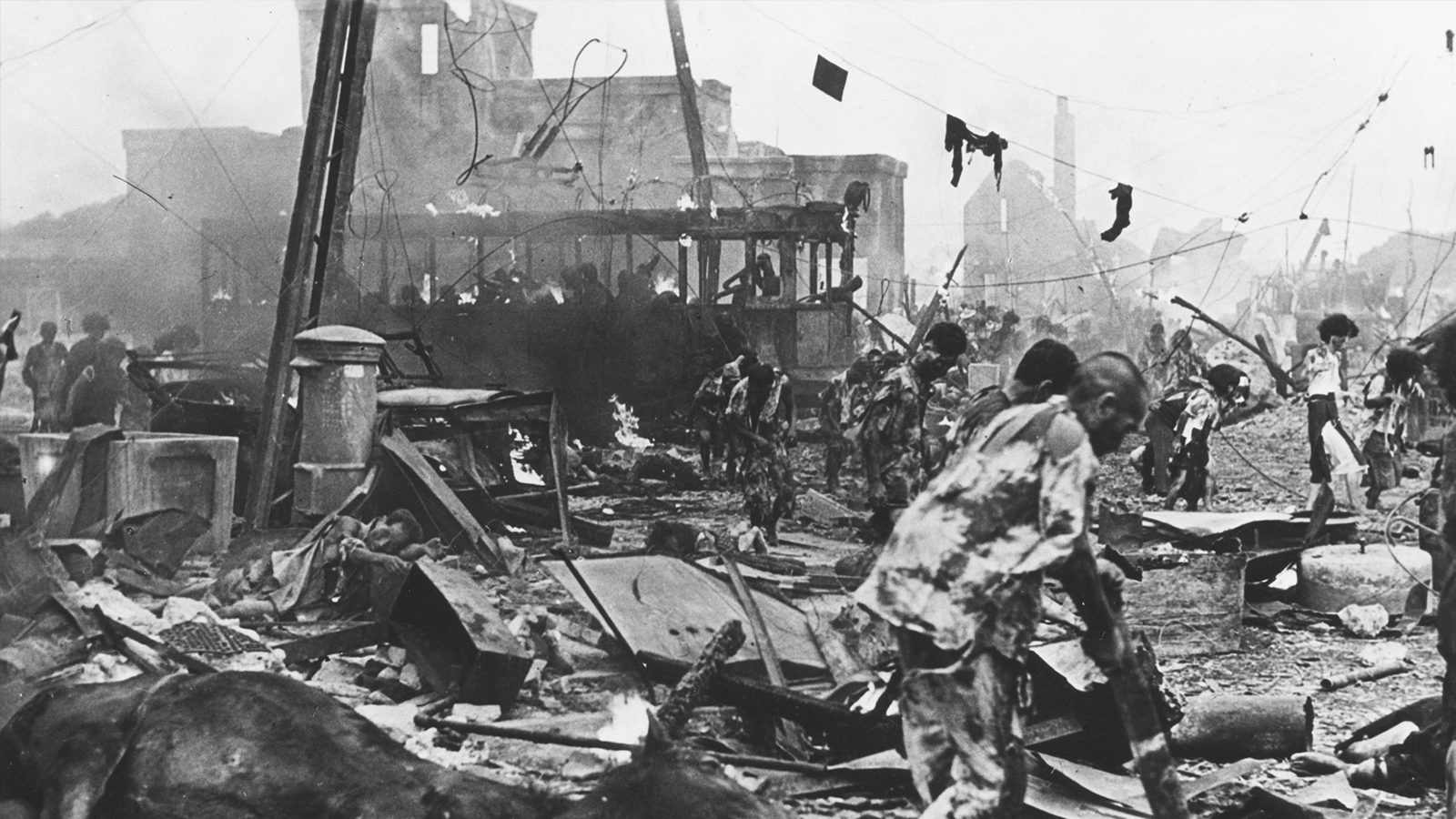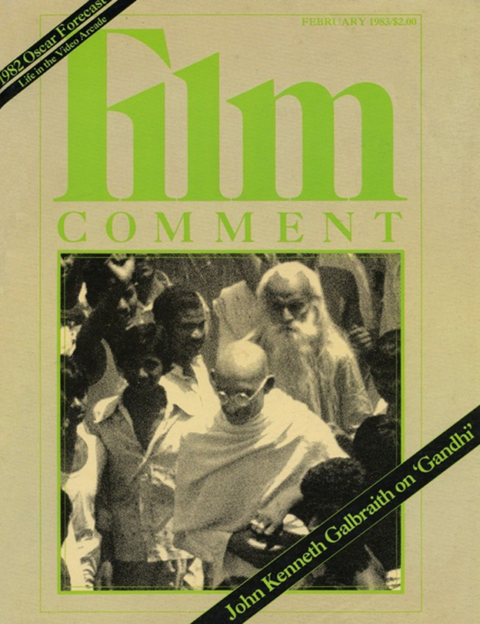By Amos Vogel in the January-February 1983 Issue

Independents: The Atom and Eve of Destruction
Amos Vogel on images of the atom bomb
The photographic record is clear: The crew smiled as it autographed its bomb. A few hours later, their tiny device had destroyed Hiroshima, killing 140,000 people in a fraction of a second.

From the January-February 1983 Issue
Also in this issue
Efficiently, an American Strategic Bomb Survey Group arrived immediately to film what was left—producing the equivalent of twenty feature-length films. It was immediately declared classified and has remained forbidden and unseen for the last thirty-five years.
One could surmise a deep, almost mystical feeling of awe, of a guilt too profound to be confrontable, hence repressed. There is, after all, the unspeakable commission of an obscene crime that, besides those flash-fired instantly, killed untold tens of thousands of victims slowly and passed on genetic damage to an unknown number of generations. Besides the bodies and the bricks there was the damaged psyche to which survivors, all Japan, and the rest of the world remain enchained.
Afterwards, the perpetrator’s assistants entered the prostrate city as cinematic conquerors, appropriating it a second time, now as filmic scavengers, for military, medical, psychological, geological, or sociological research. Such unexpectedly rich research data—with humanity as guinea pigs—yielded a windfall of knowledge, of course, for future wars. Nothing else. On the other hand, one can be grateful to the scavengers for bringing back a record of sublime human suffering and infamy that will live in history forever. In accord with great Greek myths, the scavengers could not remain untouched by what they encountered and absorbed radioactive poisons themselves.
Their camera work was unprecedented in its moral dimensions. It was as if the Nazis, for posterity and research, had filmed the results of their exterminations. Significantly, no such Nazi record exists; those events were recorded only by the Allies at war’s end. It is usually the winner who photographs the misdeeds of his enemy; in Hiroshima and Nagasaki, however, we recorded in godlike “objectivity” our own crimes and then, blinded by their unexpected glare, consecrated them co airtight vaults.
In 1951, a film society, Cinema 16, obtained from the government the horrifying The Atom Strikes: Part I, Damage to Structures. Significantly, it was unable to get the second part, Damage to People.
In 1959, Cinema 16 imported from Japan Fumio Kamei’s It ls Good to Live, with footage of the event and its aftermath. In 1970, Columbia University’s Paul Ronder and Eric Barnouw produced the moving fifteen minute shore of Hiroshima-Nagasaki, from a three hour Japanese documentary. And in 1982, the Japan Society in New York presented three evenings of “Films on Japan’s Atomic Bomb Experience”: nine films, mostly premieres, featuring the previously banned material. The audience was literally speechless, seeing what had never been seen before.
First, however, they learned about irony and imperial arrogance. Several years ago a Japanese citizen accidentally discovered the classified material in our National Archives. He began a “Ten Foot Campaign,” with individual Japanese purchasing ten feet of footage to make a film. So far, 500,000 people have contributed 140 million yen to buy 100,000 feet of film. Thus the victim—eager to learn about the moments of his deepest degradation—is “permitted” co purchase a souvenir from the perpetrator (a further tribute to the sagacity of commerce). Two of these films (one by Susumu Hani, director of Children Who Draw, and She and He) were among those shown at the Japan Society.
How can one convey the reality, texture, tragedy of these images in words? In the uncertain dusk of underdeveloped indoor shots, we see beings whose skin is coming off in strips. They are alive. Others lie insensate, their entire backs or front torsos burned off. Pitifully, a few doctors scurry about, poignant to the point of disbelief. Confronted with festering, garish wounds, they carefully dab them here and there with the tiniest of cotton wads.
There is a hand whose fingers have “fused” into a mass. A face, close-up, without a mouth or lips. Dazed people, returning to the city, ignorant of radioactivity. Thousands of charred corpses floating in the river to which they had run-hair, clothes, and bodies ablaze to escape the infernal heat. Shadows of people and plants were burned into stone-the original having vanished forever. In the wreckage of a huge school, teachers and students together learned the final lesson.
There are the tears thirty-five years after, when an otherwise composed survivor suddenly recalls the one traumatic memory, and without warning breaks down on camera, demolishing racist stereotypes of the inscrutable Oriental.
We see maggots being removed from burnt skin and organs. Stills taken two hours after impact show hundreds of dazed, maimed, bleeding beings sitting, lying, standing, screaming, or wandering-visions of living hell. Earnest scientists, weeks after, painstakingly attempt to reconstruct city maps, unable to find streets or determine who lived where. They ask passers-by to help reconstruct just one corner of one vanished street, trying by mapmaking to find their moorings amidst the incomprehensible. We see mountains of bones, uncollected after three months.
We see the half-eaten bowl of rice, bodies of children with intestines protruding, people with heads split open. Painkillers arrived only many days later. We watch the smiling girl in her hospital bed, many years after, charting the increase in her body’s leukemia cells. An old man remembers how a baby sucked her dead mother’s nipples. Then he breaks down. Another refers to “the morning the city turned black as night with hurricane winds.” The camera slowly pans across an endless number of identical jars containing grotesquely malformed fetuses, in utero when the blast struck.
After impact, there were no screams, only silence. Each person, momentarily, had his own private sun, his entire universe and being filled with it. We see victims who shiver endlessly, uncontrollably. We hear of the endless nightmares and guile of the survivors. They are shunned. They receive hate mail. In the U.S., the survivors-most of chem American citizens-cannot obtain health coverage, physicians refuse chem, the government denies legal responsibility but wants chem co participate in medical research on radiation illness. On one day a year, August 6th, they become news and are pounced upon by eager young journalists.
At Japan House, appearances by filmmakers and victims add co the surrealist atmosphere. One deathly pale survivor flown in from Tokyo chills the audience by his unaccountable dozing on stage. An American cameraman who recorded the footage suffers from cancer. (Another cameraman died.) He remembers that upon entering Nagasaki the day after, he saw a “cinema”—thrown together from loose boards-in which tattered, dazed survivors watched an American Western. On Hazel Bishop’s This Is Your Life TV show, seven “Hiroshima Maidens,” brought here for medical treatment, shake hands with the copilot of the plane chat carried the bomb. In another film, we see present-day Hiroshima: Colonel Sanders, Playboy Club, and tourists gawking at A-bomb exhibits. Celine! Kafka! Lautreamont! Pynchon!
But the image that stays lasts about a minute. It appears in every single film; no filmmaker can resist it. A baby lies on what we do not know, her serious face coward us, utterly alone. Periodically and passively, she opens her tiny mouth to slowly let out a scream—a longdrawn, totally silent scream. No sound camera was present. When it comes co an end, as all screams muse, she stops, and the process repeats, slowly, inexorably, and repeats again. It is the endless cry of the v1cttms of our crimes, activated every time a projector is turned on. She has long since died, but every time any of these films are shown, anywhere in the world, she returns. Will she stir us co action-or shall we remain frozen in impotent gestures of pity and remorse, of watching and writing about films?
For 16mm rentals/sales:
The Lost Generation and Prophecy: for forthcoming American distributor, contact: Hiroshima-Nagasaki Publishing Committee, Heiwa-kaikan 1-4-9 Shiba, Minaco-ku, Tokyo 105, Japan.
Hiroshima: Document of the Atom Bomb: Audio-Visual Center, University of Michigan, Ann Arbor, Mich.
Survivors: Survivors Film Project, 1765 Sutter Street, San Francisco, Calif. 94115.
Pikadon: Film Wright, 4530 18 Street, San Francisco, Calif. 94114; or: Union of American and Japanese Professionals Against Nuclear Omnicide, PO Box 156, Grantham, Pa. 17027.
Hiroshima-Nagasaki: Museum of Modern Art, 11 West 53rd Street, New York, N.Y. 10019
Hiroshima: Then, Now and Never: Hiroshima: the People’s Legacy: Hiroshima Maidens: NHK, Bureauchief, 1 Rockefeller Plaza, Room 1430, New York, N.Y. 10020.
Survivors of Hiroshima: Films Inc., 1144 Wilmette Avenue, Wilmette, Ill. 60091.
David Owens at Japan Society, 333 East 47th Street, New York, N.Y. 10017, will be happy co provide further information. A listing of over 100 titles on this subject may be obtained for $2 prepaid from John Dowling, Chairperson, Physics Dept., Mansfield State College, Mansfield, Pa. 16933. (Excerpts appeared in Sightlines, Vol. 15, No. 3 (c/o EFLA, 43 West 61st Sc., New York, N. Y. 10023). Another compilation is available from Media Network, 208 West 13th Sc., New York, N.Y. 10011.
Attention muse also be drawn co three outstanding books based entirely on visual materials: Briggs, When the Wind Blows (by one of England’s foremost cartoonists; a harrowing masterpiece; Schocken Books, 200 Madison Avenue, New York, N.Y. 10016); Sacred Fire (unforgettable compilation of heart-wrenching drawings done by survivors 35 years later; Pantheon Books, 201 Easet50th Street, New York, N.Y. 10022); and Days to Remember (extremely shocking compilation of stills, prepared by the Hiroshima-Nagasaki Publishing Committee, see address above).







